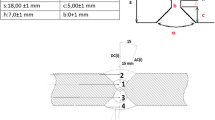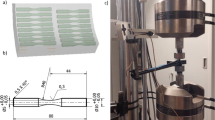Abstract
Pipelines are the most used and safest equipment to transport oil and its liquid or gaseous derivatives. Steel pipes are usually manufactured of API 5L X60, X65, X70 or X80 grade steels. x-ray diffraction technique was used to evaluate the microstructural behavior of API X65 steel samples through the analysis of the full width at half maximum (FWHM) values of the diffraction peak during the fatigue damage process. Based on the obtained results, it was possible to identify three stages of fatigue damage. Stage I is associated with crack nucleation, and a deeper understanding of this stage is one of the most relevant goals of this study. Stage II of microcracking is the longest stage, representing most of the fatigue life of the material. Stage III is related to macrocracking, when the material is already structurally harmed and driven to abrupt failure, leaving the operator with little time to act and prevent it. Another important result observed was that the major changes in the FWHM values occurred around 21% of the fatigue life of the material. This point was taken as a critical point and used as a reference to calculate the number of cycles up to the failure of the material. The results obtained show that the x-ray technique can be used to study the beginning of the fatigue life of metallic material with reliably once the FWHM results were compared with earlier indentation results that showed the same trend.











Similar content being viewed by others
References
G.P. Drumond, I.P. Pasqualino, B.C. Pinheiro and S.F. Estefen, Pipelines, Risers and Umbilicals Failures: A Literature Review, Ocean Eng., 2018, 148, p 412–425.
B.C. Pinheiro, J. Lesage, I.P. Pasqualino, N. Benseddiq and E. Bemporad, x-ray Diffraction Study of Microstructural Changes During Fatigue Damage Initiation in Steel Pipes, Mater. Sci. Eng., A, 2012, 532, p 158–166.
B.C. Pinheiro, J. Lesage, I.P. Pasqualino, E. Bemporad and N. Benseddiq, x-ray Diffraction Study of Microstructural Changes During Fatigue Damage Initiation in Pipe Steels: Role of the Initial Dislocation Structure, Mater. Sci. Eng., A, 2013, 580, p 1–12.
E. Malitckii, H. Remes, P. Lehto, Y. Yagodzinskyy, S. Bossuyt and H. Hänninen, Strain Accumulation During Microstructurally Small Fatigue Crack Propagation in bcc Fe-Cr Ferritic Stainless Steel, Acta Mater., 2018, 144, p 51–59.
B. Tomkins and W.D. Biggs, Low Endurance Fatigue in Metals and Polymers, J. Mater. Sci., 1969, 4(6), p 544–553.
P. Peralta and C. Laird, Fatigue Fracture at Bicrystal Interfaces: Experiment and Theory, Acta Mater., 1998, 46(6), p 2001–2020.
H. Vehoff and P. Neumann, In situ SEM Experiments Concerning the Mechanism of Ductile Crack Growth, Acta Metall., 1979, 27(5), p 915–920.
P. Neumann, The Geometry of Slip Processes at a Propagating Fatigue Crack-II, Acta Metall., 1974, 22(9), p 1167–1178.
P. Paris and F. Erdogan, A Critical Analysis of Crack Propagation Laws, J. Basic Eng., 1963, 85(4), p 528–533.
Bjerkén, C., & Melin, S. (2008). Influence of low-angle boundaries on short fatigue cracks studied by a discrete dislocation method. In 17th European Conference on Fracture (pp. 257-264)
C. Bjerkén and S. Melin, Growth of a Short Fatigue Crack–A Long Term Simulation Using a Dislocation Technique, Int. J. Solids Struct., 2009, 46(5), p 1196–1204.
H. Andersson and C. Persson, In-situ SEM Study of Fatigue Crack Growth Behaviour in IN718, Int. J. Fatigue, 2004, 26(3), p 211–219.
M. Jono, A. Sugeta and Y. Uematsu, Atomic Force Microscopy and the Mechanism of Fatigue Crack Growth, Fatigue Fract. Eng. Mater. Struct., 2001, 24(12), p 831–842.
D.Y. Ye, D.J. Wang and P. An, Characteristics of the Change in the Surface Microhardness During High Cycle Fatigue Damage, Mater. Chem. Phys., 1996, 44(2), p 179–181.
D. Ye, X. Tong, L. Yao and X. Yin, Fatigue Hardening/softening Behavior Investigated Through Vickers Microhardness Measurement During High- Cycle Fatigue, Mater. Chem. Phys., 1998, 56(3), p 199–204.
G. Drumond, F. Roudet, D. Chicot, B. Pinheiro and I. Pasqualino, A Damage Criterion to Predict the Fatigue Life of Steel Pipelines Based on Indentation Measurements, Journal of Offshore Mechanics and Arctic Engineering, 2020, 143(1), p 011701.
Pinheiro, B.C. (2011). Étude par Diffraction des Rayons X des Modifications Microstructurales em Cours de Fatigue, Thèse de Doctorat, Université Lille 1 - Sciences et Technologies, Lille, France.
Pinheiro, B., Lesage, J., Pasqualino, I., Benseddiq, N., & Bemporad, E. (2015, May). Toward a Fatigue Life Assessment of Steel Pipes Based on x-ray Diffraction Measurements. In ASME 2015 34th International Conference on Ocean, Offshore and Arctic Engineering (pp. V05BT04A027-V05BT04A027). American Society of Mechanical Engineers.
Q.S. Paduano, D.W. Weyburne and A.J. Drehman, An x-ray diffraction technique for analyzing structural defects including microstrain in nitride materials, J. Cryst. Growth, 2011, 318(1), p 418–422.
P.B. Hirsch and J.N. Kellar, A Study of Cold-worked Aluminum by an x-ray Microbeam Technique. I. Measurement of Particle Volume and Misorientations, Acta Crystallographica, 1952, 5(2), p 162–167.
S. Taira and K. Honda, x-ray Investigation on the Fatigue Damage of Metals, Bulletin of JSME, 1961, 4(14), p 230–237.
Taira, S., Tanaka, K., & Tanabe, T. (1970). Study of tensile deformation of low-carbon steel by x-ray microbeam technique. Proc. 13th Jap. Congr. Mater. Res, 14-9.
S. Taira and T. Keisuke, Study of Fatigue Crack Propagation by x-ray Diffraction Approach, Eng. Fract. Mech., 1972, 4(4), p 925–938.
Bragg, W. H., & Bragg, W. L. (1913). The reflection of x-rays by crystals. Proceedings of the Royal Society of London. Series A, Containing Papers of a Mathematical and Physical Character, 88(605), 428-438.
P.S. Prevéy, Problems with Non-Destructive Surface x-ray Diffraction Residual Stress Measurement, Shot Peener, The, 1992, 5(4), p 5–11.
S. Djaziri, D. Thiaudière, G. Geandier, P.O. Renault, E. Le Bourhis, P. Goudeau and D. Faurie, Controlled Biaxial Deformation of Nanostructured W/Cu Thin Films Studied by x-ray Diffraction, Surf. Coat. Technol., 2010, 205(5), p 1420–1425.
Hecker, M. (2006, February). Stresses in Laterally Structured Copper Layer Systems Studied by x‐ray Diffraction. In AIP Conference Proceedings (Vol. 817, No. 1, pp. 296-302). AIP.
Manns, T., Gibmeier, J., & Scholtes, B. (2006). Determination of Real Space Residual Stress Distributions σij (z) of Surface Treated Materials with Diffraction Methods Part I: Angle-Dispersive Approach. In Materials science forum (Vol. 524, pp. 31-36). Trans Tech Publications.
C. Genzel, x-ray Stress Analysis in Presence of Gradients and Texture, Adv. x-ray Anal., 2001, 44, p 247.
Q. Luo and A.H. Jones, High-precision Determination of Residual Stress of Polycrystalline Coatings using Optimized XRD-sin2ψ Technique, Surf. Coat. Technol., 2010, 205(5), p 1403–1408.
G.C.A.M. Janssen, Stress and Strain in Polycrystalline Thin Films, Thin Solid Films, 2007, 515(17), p 6654–6664.
P. Scardi, P. Polonioli and S. Ferrari, Residual Stress in Stabilized Zirconia Thin Films Prepared by rf Magnetron Sputtering, Thin Solid Films, 1994, 253(1–2), p 349–355.
V. Teixeira, M. Andritschky, W. Fischer, H.P. Buchkremer and D. Stöver, Effects of Deposition Temperature and Thermal Cycling on Residual Stress State in Zirconia-Based Thermal Barrier Coatings, Surf. Coat. Technol., 1999, 120, p 103–111.
B.E. Warren and B.L. Averbach, The Separation of Cold-Work Distortion and Particle Size Broadening in x-ray Patterns, J. Appl. Phys., 1952, 23(4), p 497–497.
B.E. Warren and B.L. Averbach, The Separation of Stacking Fault Broadening in Cold-Worked Metals, J. Appl. Phys., 1952, 23(9), p 1059–1059.
G.K. Williamson and W.H. Hall, x-ray Line Broadening from Filed Aluminum and Wolfram, Acta Metall., 1953, 1(1), p 22–31.
I. Groma, x-ray Line Broadening Due to an Inhomogeneous Dislocation Distribution, Phys. Rev. B, 1998, 57(13), p 7535.
L.V. Azaroff, Elements of x-ray Crystallography, Mc Graw-Hill, New York, 1968, p 549–558
B.E. Warren, x-ray Diffraction, Dover Publications, New York, 1990, p 251–252
Y. Akiniwa, S. Machiya and K. Tanaka, Fatigue Damage Evaluation in SiCp/2024 by x-ray Diffraction Method, Int. J. Fatigue, 2006, 28(10), p 1406–1412.
Y. Akiniwa, S. Machiya, H. Kimura, K. Tanaka, N. Minakawa, Y. Morii and T. Kamiyama, Evaluation of Material Properties of SiC Particle Reinforced Aluminum Alloy Composite Using Neutron and x-ray Diffraction, Mater. Sci. Eng., A, 2006, 437(1), p 93–99.
Fourspring, P. M., & Pangborn, R. N. (1997). An x-ray Diffraction Study of Microstructural Deformation Induced by Cyclic Loading of Steels. In Fatigue and Fracture Mechanics: 28th Volume. ASTM International.
A. Olchini, H. Stamm and F.D.S. Marques, Fatigue Damage Monitoring of Laser Surface Treated Steel by x-ray Diffraction Methods, Surf. Eng., 1998, 14(5), p 386–390.
R.N. Pangborn, S. Weissmann and I.R. Kramer, Prediction of Fatigue Life by x-ray Diffraction Methods, Fatigue Fract. Eng. Mater. Struct., 1979, 1(3), p 363–369.
K. Vijayan, A. Mani, C. Balasingh and A.K. Singh, x-ray Analysis of Polycrystalline Aluminum Subjected to Fatigue Cycling, Bull. Mater. Sci., 1988, 10(3), p 205–216.
H.K. Kuo and J.B. Cohen, Changes in Residual Stress, Domain Size and Microstrain During the Fatigue of AISI 1008 Steel, Mater. Sci. Eng., 1983, 61(2), p 127–136.
R.N. Pangborn, S. Weissmann and I.R. Kramer, Dislocation Distribution and Prediction of Fatigue Damage, Metall. Trans. A, 1981, 12(1), p 109–120.
R.A. Winholtz and J.B. Cohen, Changes in the Macrostresses and Microstresses in Steel with Fatigue, Mater. Sci. Eng., A, 1992, 154(2), p 155–163.
K. Tanaka, Recent x-ray Diffraction Studies of Metal Fatigue in Japan, Journal of Strain Analysis, 1975, 10(1), p 32–41.
J. Lesage, D. Chicot, P. Perez and J.M. Chatelet, x-ray Diffraction Study of Microstructural Modifications During Fatigue, Euromat, 1994, 94(2), p 616–620.
A.P.I. Spec, 5L: Specification for Line Pipe, American Petroleum Institute, 2012, 4, p 14577–14581.
Standard, A. S. T. M. (2004). E8M-04. Stand Test Methods Tens Test Met Mater West Conshohocken ASTM Int.
Laird, C. (1967). ASTM STP 415. In American Society for Testing and Materials (pp. 131-169).
M.D. Abràmoff, P.J. Magalhães and S.J. Ram, Image processing with ImageJ, Biophoton. Int, 2004, 11(7), p 36–42.
Schenck, C., Wechselbiegemaschine PWON, Maschinenfabrik GmbH, Darmstadt, Germany, 1971.
DIN, E. (1982). 50142. Testing of metallic materials. Flat bending fatigue test. Deutsches Institutfür Normung.
Shigley, J. E., & Mischke, C. R. (2008). Fatigue Failure Resulting from Variable Loading. Mechanical Engineering Design, 370-73.
AFNOR (1999). Association Française de Normalisation, Essais non destructifs – Méthodes d’essais pour l’analyse des contraintes résiduelles par diffraction des rayons X, XP A 09-285, Paris.
J.I. Ning and J.L. Lebrun, Microstructural Study of Static and Dynamic Deformed Polycrystalline Copper by x-ray Diffraction Profile Analysis, Scr. Metall. Mater., 1990, 24(8), p 1547–1552.
K. Dalaei, B. Karlsson and L.E. Svensson, Stability of Residual Stresses Created by Shot Peening of Pearlitic Steel and Their Influence on Fatigue Behaviour, Procedia Eng., 2010, 2(1), p 613–622.
Lawn, B. R. (1980). A. G, Evans and DB Marshall. J. Am. Ceram. Soc, 63: 574.
N.A. Sakharova, J.V. Fernandes, J.M. Antunes and M.C. Oliveira, Comparison Between Berkovich, Vickers and Conical Indentation Tests: A Three-dimensional Numerical Simulation Study, Int. J. Solids Struct., 2009, 46(5), p 1095–1104.
E.S. Palma, T.R. Mansur, S.F. Silva Jr. and A. Alvarenga Jr., Fatigue Damage Assessment in AISI 8620 Steel Using Barkhausen Noise, Int. J. Fatigue, 2005, 27(6), p 659–665.
Acknowledgment
This study was financed in part by the Coordination of Superior Level Staff Improvement, in Portuguese, Coordenação de Aperfeiçoamento de Pessoal de Nível Superior—Brasil (CAPES)—Finance Code 001. The authors also acknowledge financial support from the CAPES/COFECUB which made the collaboration between the two laboratories (LTS—Brazil and LGCgE—France) possible.
Author information
Authors and Affiliations
Corresponding author
Additional information
Publisher's Note
Springer Nature remains neutral with regard to jurisdictional claims in published maps and institutional affiliations.
Rights and permissions
About this article
Cite this article
Drumond, G., Pinheiro, B., Pasqualino, I. et al. Fatigue Life Prediction of Steel Pipelines Based on X-ray Diffraction Analyses. J. of Materi Eng and Perform 31, 801–813 (2022). https://doi.org/10.1007/s11665-021-06230-0
Received:
Revised:
Accepted:
Published:
Issue Date:
DOI: https://doi.org/10.1007/s11665-021-06230-0




